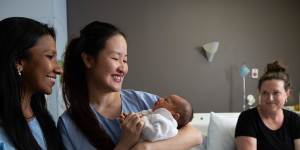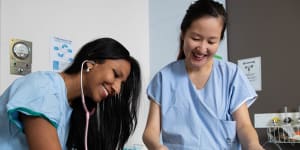“If I think about my consultants when I started,the vast majority would be men,” she recalled.

Obstetricians Kaushi Arulpragasam,left,and Stephanie Sii,right,with four-day-old Richie Hicks and his mum,Rhiannon,at the Royal Hospital for Women in Randwick.Janie Barrett
Now,the hospital has reached gender parity among its consultants and,of its 28 trainees,just four are men.
The statistics fit into a wider trend in obstetrics:once male-dominated,the field of medicine related to childbirth and pregnancy is increasingly a specialisation practised by women.
Data from the Royal Australian and New Zealand College of Obstetricians and Gynaecologists (RANZCOG) 2019-20 annual report showed almost exact gender parity among fellows (1153 men and 1140 women).
However,among trainees the ratio of women to men was much higher,with more than four in five of the college’s 792 trainee members identifying as women.

Obstetricians Kaushi Arulpragasam and Stephanie Sii with baby Richie Hicks.Janie Barrett
And,as has been seen at the Royal Hospital for Women’s staff,there is evidence they are staying around.
“As I moved through,the people who were retiring were older men,and they were being replaced by women,” Dr Clements said.
A 2019 report on gender equity in obstetrics and gynaecology in RANZCOG found,although the number of women in the field had been slowly on the rise since the 1980s,it had increased rapidly since the mid-2000s.
In the year 2000 women were 20 per cent of the college’s fellows. By 2010 the proportion had grown to 37 per cent and by 2015 it was 45 per cent before reaching parity in 2018.
Over the same time period,women trainees grew from 60 per cent of the cohort to 83 per cent.
Dr Greg Jenkins,chair of training and accreditation at RANZCOG,said the field was bucking the trend seen in some other professions,where high numbers of women graduates don’t translate to higher numbers of women in senior positions.
Asked as to why he thought the gender shift had occurred,he said it was “a speciality that generally attracts women” and numbers may have benefited from more women in medicine overall.
Dr Jenkins said,while it may be requested by some patients that only women are in the delivery room possibly creating “a little bit of a barrier” to engagement with medical student placements,it was important for the college that both men and women were considering obstetrics.
“Really we do want a balance ... we want to see a broad section of society represented in our specialist workforce,” he said.
“But we do have these incredible,fabulously talented and intelligent women who have come through a training program and so it’s just such an exciting time for us.”
In 1990,Dr Therese McGee was the first woman to be appointed as an obstetrics and gynaecology consultant at Westmead Hospital,after a string of men since the department opened in 1978.
“Conversely,of the 12 or so consultant appointments in the past five to seven years,all have been women,” Dr McGee said.
Dr Kaushi Arulpragasam,an obstetrics trainee at the Royal and a mother of a one-year-old,said she did think having a personal insight into women’s health assisted in her work,although she had seen her male colleagues be just as good at their roles.
“It takes a certain type of person – all doctors are empathetic – but these women want to be heard at the end of the day,so you need a caring personality,” she said.
Donate to The Royal Hospital for Women’s.
The Morning Edition newsletter is our guide to the day’s most important and interesting stories,analysis and insights.